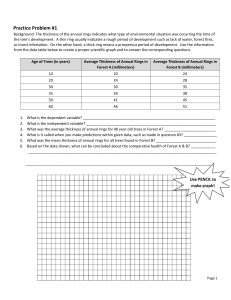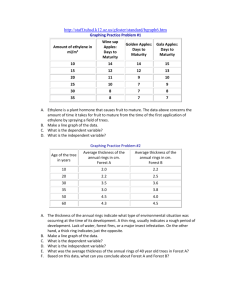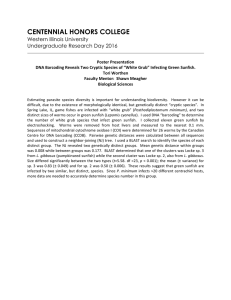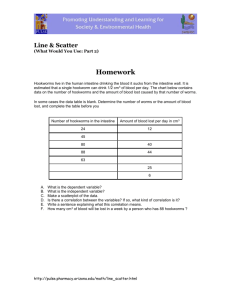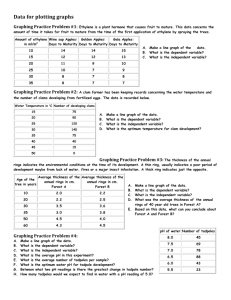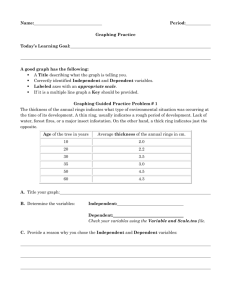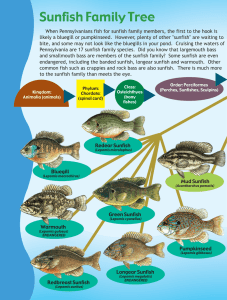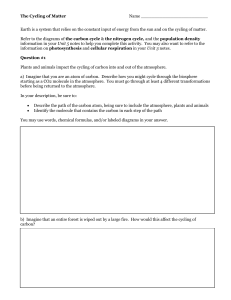Graphing Practice Independent vs. Dependent Variable A student
advertisement
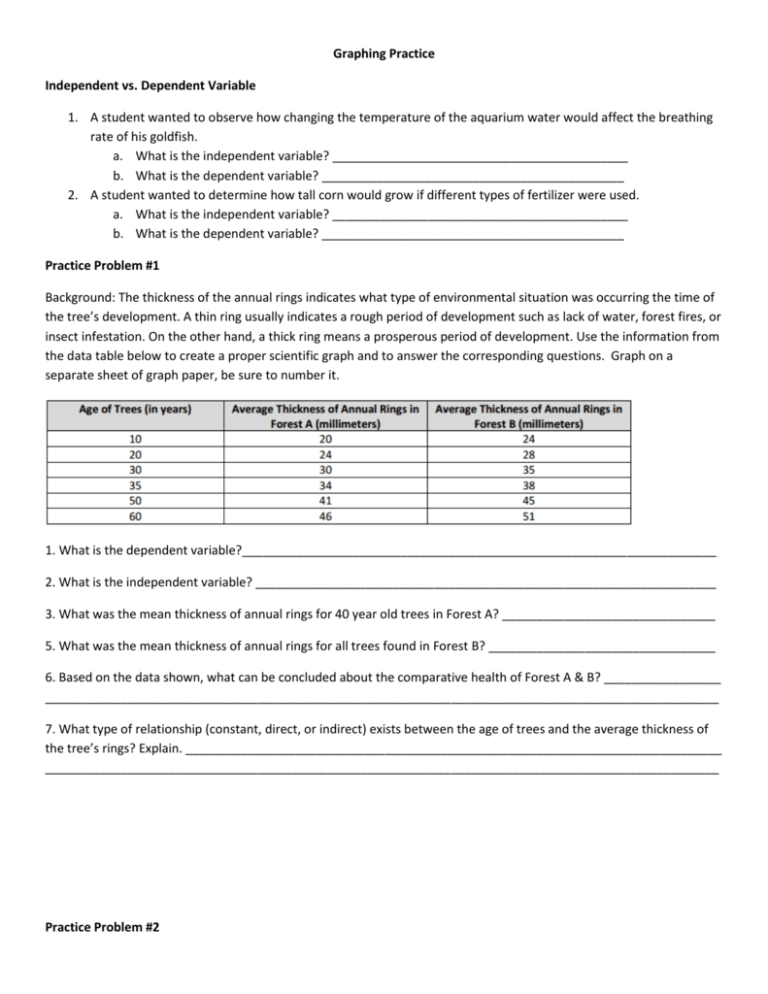
Graphing Practice Independent vs. Dependent Variable 1. A student wanted to observe how changing the temperature of the aquarium water would affect the breathing rate of his goldfish. a. What is the independent variable? ___________________________________________ b. What is the dependent variable? ____________________________________________ 2. A student wanted to determine how tall corn would grow if different types of fertilizer were used. a. What is the independent variable? ___________________________________________ b. What is the dependent variable? ____________________________________________ Practice Problem #1 Background: The thickness of the annual rings indicates what type of environmental situation was occurring the time of the tree’s development. A thin ring usually indicates a rough period of development such as lack of water, forest fires, or insect infestation. On the other hand, a thick ring means a prosperous period of development. Use the information from the data table below to create a proper scientific graph and to answer the corresponding questions. Graph on a separate sheet of graph paper, be sure to number it. 1. What is the dependent variable?_____________________________________________________________________ 2. What is the independent variable? ___________________________________________________________________ 3. What was the mean thickness of annual rings for 40 year old trees in Forest A? _______________________________ 5. What was the mean thickness of annual rings for all trees found in Forest B? _________________________________ 6. Based on the data shown, what can be concluded about the comparative health of Forest A & B? _________________ __________________________________________________________________________________________________ 7. What type of relationship (constant, direct, or indirect) exists between the age of trees and the average thickness of the tree’s rings? Explain. ______________________________________________________________________________ __________________________________________________________________________________________________ Practice Problem #2 Background: Clams were placed into various temperatures of water. Use the information in the data table below in order to create a proper scientific graph and to answer the corresponding questions. Graph on a separate sheet of graph paper, be sure to number it. 1. What is the dependent variable? ________________________________________________________________ 2. What is the independent variable? _______________________________________________________________ 3. What is the optimum temperature for clam development? ___________________________________________ 4. What is the mean number of clams per sample? ____________________________________________________ 5. Approximately how many clams would be developing in 10 degree Celsius water? _________________________ Practice Problem #3 Background: Natalie sets out to run 15 kilometers. Every 30 minutes she checked her pedometer to determine how far she had run. Use the data below to create a proper scientific graph and to answer the corresponding questions. 1. What is the dependent variable? ________________________________________________________________ 2. What is the independent variable? _______________________________________________________________ 3. How many kilometers had Natalie run after 40 minutes? _____________________________________________ 4. What was Natalie’s average speed (in kilometers per hour) over the course of her run? ____________________ Use the formula Speed = Distance / Time Practice Problem #4 Background: Match each story on the left with the graph it represents on the right. Each graph compares the distance a car is from home compared to time. ____1. I had just left home when I realized I had forgotten my books, so I went back to pick them up. ____2. The battery on my electric car started to run down. ____3. Things went fine until I had a flat tire. ____4. I started out calmly, but sped up when I realized I was going to be late. Practice Problem #5 Background: The pie chart shows the approximate percentages teenagers spend doing various activities in a day. Use the information in the pie chart to answer the questions below. 1. What percent of the day is spent watching TV? _______ 2. How many hours are spent sleeping? _______ 3. What activity takes up the least amount of time? __________ 4. What activity takes up a quarter of the day? __________ 5. What two activities take up 50% of the day? __________ 6. What two activities take up 25% of the day? __________ Practice Problem #6 1. What is the dependent variable? ____________________ 2. Does the price per bushel always increase with demand? ________________________________________ 3. What is the quantity demanded when the price is $5 per bushel? ________________________________________ 4. What is the price per bushel when the quantity demanded is 80? ________________________________________ Practice Problem #7 Background: The rate of respiration of a freshwater sunfish was determined at different temperatures. The rate of respiration was determined by counting the number of times the gill covers of the fish opened and closed during 1minute intervals at the various temperatures. Use the information in the data table below in order to create a proper scientific graph and to answer the corresponding questions. Graph on a separate sheet of graph paper, be sure to number it. _____1. According to the data, as the temperature increases, the rate of respiration of the sunfish a) b) c) d) increases steadily decreases steadily increases, then decreases decreases, then increases _____2. Which title is appropriate for this graph? a) b) c) d) The Effect of Temperature on Rate of Respiration in Sunfish The Effect of Gill Movement on Rate of Respiration in Sunfish The Relationship Between Temperature and Dissolved Oxygen The Relationship Between Sunfish Population and Temperature Change in Freshwater Habitats Practice Problem #8 Background: The data table shows water temperatures at various depths in an ocean. 3. State the general relationship between temperature and water depth. _____4. The approximate water temperature at a depth of 125 meters would be closest to a) 15°C c) 8°C b) 13°C d) 3°C
